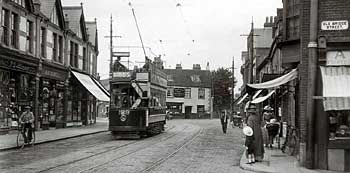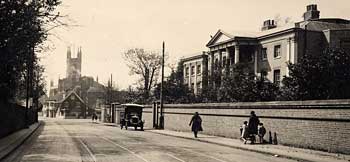
We have seen how a number of factors influenced the rapid growth of the area in the last 30 years or so of the last century. These events were the coming and growth of the Water Companies from the mid 1850’s, the coming of the railway in 1864, the growth of nurseries and the “opening-up” of Hampton Hill, principally by the vicar, The Rev. Fitzroy John Fitzwygram.
By the turn of the century much of the outline of the road pattern that we know to-day had been laid out (even if not yet built up). Indeed the principal pattern of the roads in Hampton was laid out centuries ago by the roads and tracks to and around the fields, as well as the main roads to Staines, Chertsey and Twickenham. There were two major exceptions to this. One was the Manor Park Estate, which was given planning permission in 1897 and did not really start until the first decade of the 20th century and was continually developed with the Manor House itself and surrounding lands (east of the railway line and north of Ormond Crescent) not being developed until after the demolition of the Manor House in 1935-6.
The other exception was the “Nurserylands” development, which was the result of successive developers who, despite trying since the 1860’s had failed in the main to develop much of the former Tangley Park (Marling Park) estate. This had then been used as nurseries and was not finally developed until the 1970’s and 1980’s. Most of the nurseries were located in this area, although there were a number on the western side of Hampton, particularly in the Ripley Road area and others on the Manor Park Estate before it was built up (mainly off Broad Lane and around Carlisle Park). In total there had been 12 nurseries in 1888, 32 by the turn of the century, and 45 in 1939 which then declined until the were only 8 left in 1973.

The remaining building and development this century (other than the Manor Park Estate and the main recent Nurserylands development) was the infilling of the remaining fields and other nurseries on the western and northern sides of Hampton.
Thus we reach the present where development has in essence reached saturation point, except for any building that may take place on the Waterworks land now owned by Thames Water plc. However, if you look carefully at successive Ordnance Survey maps it is still easy to see the former field patterns from those far off days clearly fixed in the pattern of the street layouts that exist today.

